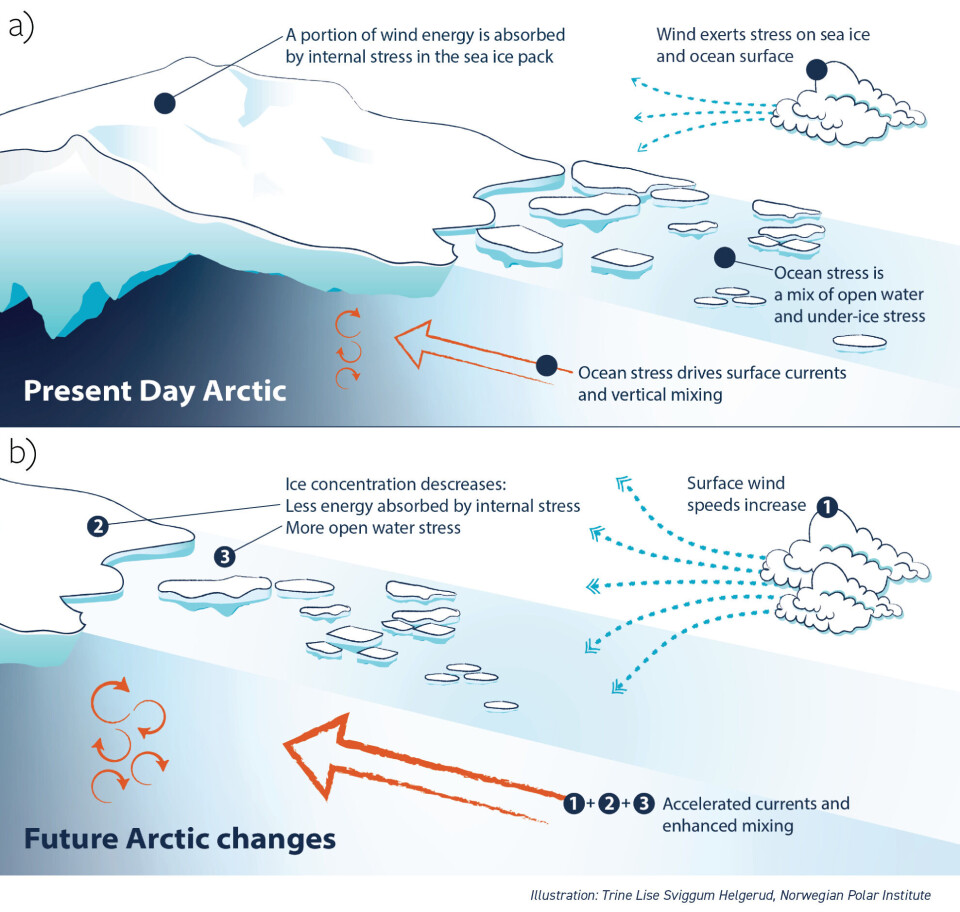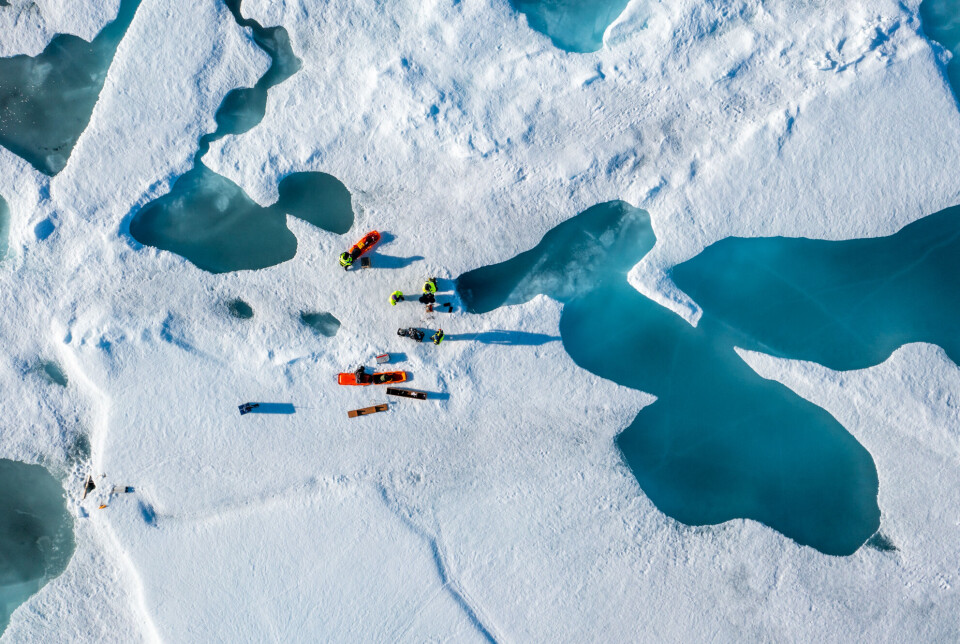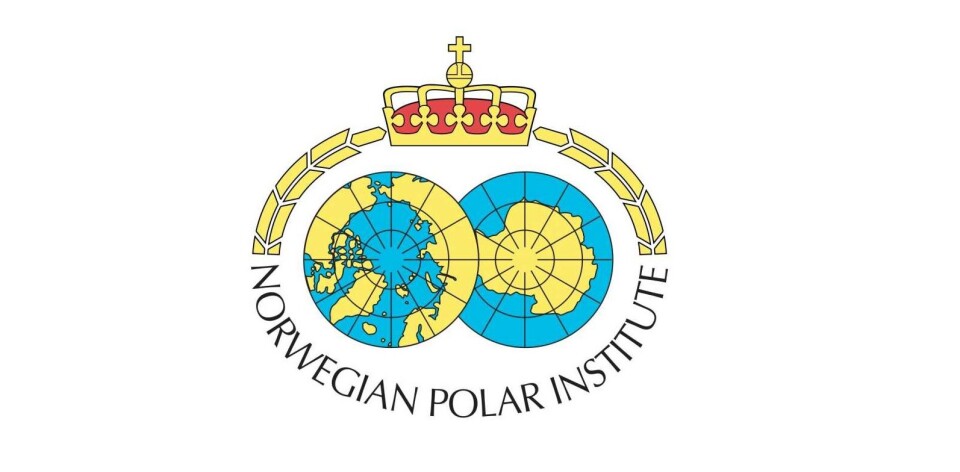THIS CONTENT IS BROUGHT TO YOU BY the Norwegian polar institute - READ MORE

The Arctic Ocean will be unrecognisable by 2100
In the coming decades, the Arctic Ocean will change dramatically from a calm, ice-covered sea to a more open ocean with stronger currents.
On an ice floe in the central Arctic Ocean, there is intense research activity. The research vessel Kronprins Haakon has stopped so that researchers can take measurements over the next 24 hours.
Climate scientist Morven Muilwijk is deploying an instrument to measure the ocean currents beneath the ice floe he is standing on. He knows that the currents he is measuring today will be very different in a few years.
“We are here now, taking measurements of the current state of the Arctic Ocean, while also working on future projections that show the area is changing rapidly. Our latest study clearly shows that the physics and ecosystems of the Arctic Ocean will change significantly in the next 10, 50, and 75 years,” he says.
The researchers' calculations show what the future Arctic Ocean will look like. They were made using the same climate models that were used in the IPCC's Sixth Assessment Report.
“The models show that as the Arctic Ocean continues to warm due to global warming, wind speeds will increase, and sea ice will decrease. Our study focuses on the consequences of this,” he says.
Less ice affects ocean currents
The sea ice in the Arctic acts as a stable lid. It shields the water masses from direct wind influence for much of the year. Today, the Arctic Ocean is a calm sea with weak currents and little mixing.
With less area is covered by sea ice due to climate change, the ocean becomes more exposed to wind. Additionally, stronger winds will enhance surface currents, eventually leading to movement deeper into the water column.
“Stronger winds and less sea ice mean that more energy is transferred from the atmosphere to the ocean, with significant consequences for ocean circulation and stratification in the Arctic Ocean,” says Muilwijk.
The study shows that there could be a 38 per cent increase in wind influence on the ocean surface by the end of the century (year 2100. Some models suggest increases of up to 72 per cent compared to today.

New findings on wind energy
The researchers have uncovered a new, important mechanism: A weaker ice cover amplifies the effect of increased wind. This leads to even stronger energy transfer from the atmosphere to the ocean.
Previously, a significant portion of the wind energy was absorbed by the thick, rigid ice cover, which, among other things, led to the formation of pressure ridges in the ice.
“As the ice cover becomes thinner and more mobile, it absorbs much less wind energy. Instead, the wind energy is transferred more directly through the ice to the ocean,” the researcher says.
Sea ice can melt from below
The researchers on the Arctic Ocean cruise 2024 are mapping the current state of the Arctic Ocean. There are few observations from this area, but it is precisely here that the effects of global climate change will be greatest.

The current state will therefore serve as a reference for measuring changes. Researchers call this the 'baseline.' Establishing a baseline is crucial for assessing the impact of climate change over time.
The Arctic Ocean, as researchers know it today, has a distinct stratification in the water column: Fresh, cold polar water at the surface and salty, warm Atlantic water deeper down.
The polar water has a lower density than the salty Atlantic water and therefore sits higher in the water column. The models show that stronger wind influence will alter this distinct stratification in the Arctic Ocean.
“The warm water will mix upwards from the depths and can contribute to melting the sea ice from below. This, in turn, reinforces the ongoing changes due to global warming,” explains Muilwijk.
Ecosystems will change
Changes in ocean stratification will affect marine life. The mixing determines how nutrients are distributed in the water column. With increased mixing, nutrients from the depths are stirred upwards, making them available to phytoplankton living in the top 50 metres of the water.

Phytoplankton depend on nutrients and light to perform photosynthesis, just like plants on land, and they serve as food for the rest of the food chain. When phytoplankton have better conditions to grow, it creates ripple effects throughout the entire ecosystem.
Could affect global climate
Ocean currents transport large amounts of energy around the Earth, influencing the global climate.
One example is the warm Gulf Stream, which helps give Northern Europe a milder climate than Alaska, which is at similar latitudes. The Gulf Stream is one of several ocean currents in the North Atlantic that are sensitive to changes further north.
“As stronger ocean currents develop in the Arctic Ocean, the distribution of cold freshwater will change, which in turn affects ocean circulation in the North Atlantic and thus the climate of the Northern Hemisphere,” says Muilwijk.
The new research will give climate scientists a deeper understanding of the relationship between sea ice, the ocean, and the atmosphere. This insight could influence future climate modelling and research on the Arctic Ocean. Additionally, this knowledge can be used to plan how we should manage these areas in the future.
References:
Muilwijk et al. Future sea ice weakening amplifies wind-driven trends in surface stress and Arctic Ocean spin-up, Nature Communications, vol. 15, 2024. DOI: 10.1038/s41467-024-50874-0
































